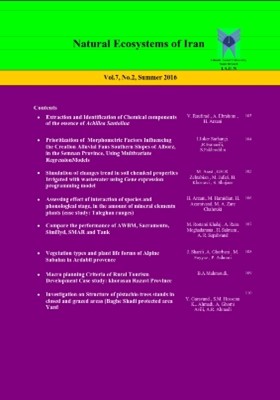معیارهای برنامهریزی کلان توسعه گردشگری روستایی در کشور مطالعه موردی: استان خراسان رضوی
الموضوعات :
1 - دانشگاه شهرکرد
الکلمات المفتاحية: استان خراسان, روش دلفی, توسعه گردشگری روستایی, معیارهای برنامهریزی,
ملخص المقالة :
در این تحقیق، برنامه ریزی کلان توسعه گردشگری روستایی در سطح استان خراسان رضوی، از طریق جمع آوری و تدوین معیارهای موثر و اولویت بندی آنها بر اساس روش دلفی صورت پذیرفت. پس از تعیین امتیاز و اولویت معیارها، نقشه کلان مناطق مستعد برنامه ریزی گردشگری روستایی بدست آمد. مطابق این بررسی از 8 گروه معیار گردشگری، محیطی، کالبدی– زیرساختی، اقتصادی، فرهنگی– اجتماعی، طراحی، مدیریتی و معماری 24 معیار اصلی و 89 زیرمعیار شناسایی گردید. در این راستا بیشترین زیرمعیارها در گروه معیار فرهنگی– اجتماعی با 19 معیار و کمترین آنها در گروه معیار مدیریتی است که 5 معیار را در برگرفته است. نتایج دلفی برای گروه معیارها نشان داد گروه معیارهای گردشگری، محیطی، فرهنگی – اجتماعی، کالبدی – زیرساختی، معماری، اقتصادی، طراحی و مدیریتی به ترتیب دارای اولویت 1 تا 8 هستند. مطابق بررسی انجام گرفته برای سطح بندی میزان تاثیرگذاری زیرمعیارها، 3/8 درصد از زیرمعیارها در طبقه با تأثیرگذاری بسیار زیاد، 6/22 درصد در طبقه با تأثیرگذاری زیاد، 7/35 درصد تأثیرگذاری متوسط و 4/33 درصد در طبقه تأثیرگذاری کم واقع شده اند. همچنین نتایج نشان داد زیر معیارهای جاذبه ها و مقاصد گردشگری، تقاضا و بازار گردشگری، پوشش گیاهی، اقلیم، امنیت، مخاطرات محیطی و موقعیت نسبت به محورهای گردشگری به ترتیب بیشترین اولویت را داشته اند.
- Boyerahmad Province), Journal of Geographical Research, 95.(In Persian).
- Balli, S., & S, Korukoglu, 2009. Operating System Selection Using Fuzzy AHP And Topsis Methods, Mathematical and Computational Applications. 4 (2): 119-130.
- Bhattacharya, P., & S, Kumari, 2004. Application of Criteria and Indicator for Sustainable Ecotourism, Submitted for the IASCP Bi-Annual Conference on (The Commons in an Age of Global Transition: Challenges, Risk and Opportunities at Oaxaca, Mexico.
- Brown, K., 2001. Trade-off analysis for marine protected area management, Journal of Ecological Economics, 37:417-434.
- Bunruamkaewa, K., & Y, Murayamaa, 2011. Site Suitability Evaluation for Ecotourism Using GIS & AHP: A Case Study of Surat Thani Province , Thailand, Procedia Social and Behavioral Sciences 21, 269–278.
- Castellani, V., S, & Sala, 2009. Sustainable performance index for tourism policy development, University of Milano Bicocca, Department of Environmental Science, Piazza della Scienza 2026 Milano, Italy, Tourism Management, 1:45-58.
- Danehkar, A., & B. Mahmoudi, 2013. Nature Tourism, Jahad of university press, 293p. .(In Persian).
- Danehkar, A., and H. Majnonian, 2004. Proposed criteria for evaluation coastal – marine in order to determine coastal-marine protected areas of Iran, Case study: evaluation of protected areas in the Caspian Sea, Journal of Environmental Studies. 35, 9-32. (In Persian).
- Egger, S., 2006. Determining a Sustainable City Model, Environmental Modeling and Software. 21, 1235-1246.
- Fletcher, S., 2001. Planning policy and development guidelines for ecotourism development within the northern rivers new south wales region, Prepared by Nature Tourism Task Force.
- Ghaderi, Z. 2004. Principles of sustainable development of rural tourism, publications of Iran Municipalities and Rural Management Organization. .(In Persian).
- Hatzichristos, T., and M. Giaoutzi, 2006. Landfill siting using GIS, fuzzy logic and the Delphi method, International Journal of Environmental Technology and Management.
- Jamrozy, U., 2007. Marketing of Tourism: A Paradigm Shift Toward sustainability International journal of culture, tourism and hospitality research. 2(1): 117-130.
- Jerry Ho, WR., 2010. Combined DEMATEL technique with a novel MCDM model for exploring portfolio selection based on CAPM Expert Systems with Applications.
- Kitsiou, D,. 2002. Multi-dimensional evaluation and ranking of coastal areas using GIS and multiple criteria choice methods” Journal of The science of Total Environment. 284,1-17.
- Kumari, S., 2010. Identification of Potential Ecotourism Sites in West District, Sikkim using Geospatial Tools, Tropical Ecology. 51, 75-85.
- Mahmoudi, B., Ahmadian, R., and A. Haghsetan, 2013. Macro planning of tourism sample regions through selecting effective criteria on tourism planning process in Khorasan Razavi Province, Journal of Natural Environment, 66(4): 423-434. .(In Persian).
- Makhdoum, M., 2001.Fundamental principles of Land use planning, Fifth Edition, Tehran, University of Tehran Publications, .(In Persian).
- Manely, C., 1990. what is tourism, Journal of tourism studies. 11(1):251-267.
- Minciardi, R., 2008. Multi-objective Optimization of Solid Waste Flows: Environmentally Sustainable Strategies for Municipalities, Waste Management. 28, 113-126.
- Nouri, J., 2008. Evaluation of ecotourism potential in northern coastline of the Persian Gulf” Journal of Environ Geology, 55(3):681-686.
- Powell, C,. 2003. The Delphi technique: Myths and realities, Methodological Issues in Nursing Research, 41(4):2132-2146.
- Rosa, E., Eduardo. G, and J, Erin, 2005. Social adaptation ecotourism in the Lacandon forest, Annals of Tourism Research. 32, 610 - 627 .
- Sarvar, R., 2011. Applied geography and land use planning, Samt press, 182p.
- Tourism, Cultural Organization, 2007. Tourism plan of Kurdistan province, volume,1:323p.
- Tourism, Cultural Organization, 2008. Guidelines and roles for tourism area plan, 126p.
- Tremblay, P., 2006. Desert Tourism Scoping, Study Desert knowledge CRC, 54 p.
- Tsai, WH., 2010. An integrated approach for selecting corporate social responsibility programs and costs evaluation in the international tourist hotel, International Journal of Hospitality Management. 29, 385-396.
- WTO/UNEP/IUCN, 2001. Guidelines: Development of National Parks and Protected Areas for Tourism IUCN, Gland, Switzerland In: Henric Majnounian, Iran Protected Area, Department Of Environment, 598p


